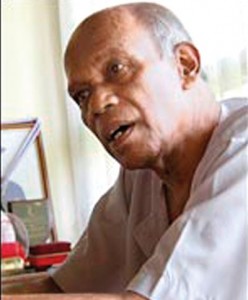Goodbye, my friend!
Much has been written about Professor Tissa Kariyawasam over the past week or more following his death. He certainly deserves a tribute in ‘Kala Korner’ for his immense service, particularly in the fields of Sinhala theatre and literature. He was as an academic, researcher, communicator and administrator.
My association with Tissa goes back to the heyday of Sinhala theatre in the late 1960s and ‘70s when we used to meet often along with the then chairman of the Arts Council Sinhala Drama Panel, H.D. Sugathapala. Both ‘Sugar’, as HDS was fondly called, and Tissa appreciated the Arts column in the Sunday Observer which highlighted theatre activities and the focus on dramatists and playwrights whom the English readership was virtually unaware of. Tissa was then a Drama Panel member. Years later he served as chairman.
When Tissa started the Department of Mass Communications at the Sri Jayawardenapura University he invited me to be a visiting lecturer which I gladly accepted as a contribution towards his efforts to build up professional journalists.
Not many may remember his role as a dramatist. In the 1970s he wrote several dramas including ‘Parasathawa’ & ‘Porisadaya’ (translations) and ‘Higanna’. He has directed at least two plays -’Ane Ablick’ and ‘Siri Sangabo’. He also scripted ‘Muthu Aeta’, an adaptation.
Tissa’s main contribution to Sinhala theatre, however, was in the field of research and recording its history from 1867 onwards. This has been done in several volumes covering the period up to 1956. He has done a separate book on the evolution of university drama from 1921 – 81. Among his other work is a study of Chinese drama and the art of acting.
When he was pursuing his post-graduate studies, he concentrated on traditional rituals and published a book on Exorcist Rituals in the low-country.
Equally proficient in Sinhala and English, he had a style of his own whenever he delivered a talk.
D.R. Wijewardene address
When he was invited as guest speaker at the D.R. Wijewardene Memorial Award presentation, his theme was ‘The Style of Communication of the Sinhala Novel and the Development of Mass Media’. He described Mr. Wijewardene as “the pioneer who envisioned and determined the course of history, of politics, higher education, new forms of fine arts, and creative literature of the 20th century Sri Lanka.”
Tissa said that the newspaper institution he founded under his leadership was “a whetstone which many a writer who made a mark in the field of modern creative literature sharpened his literary teeth”. He mentioned T.G.W. de Silva, G.B. Senanayake and Martin Wickremasinghe as some of those writers.
To him the D.R. Wijewardene Memorial Award through an open literary competition was the most fitting tribute to perpetuate the memory of such a great person to fulfil the ideals he cherished in his lifetime and pass it on to future generations.
His advised on how a novel or short story should be developed. “Experiences gained by man in his day-to-day life are basic to the novel or a short story. Experience cannot be arbitrarily acquired. They have to be gained through meticulous observation of and intensive enquiry into human condition and behaviour, as well as what happens in society and in one’s environment. Experiences can also be intensified by reading. But presenting every incident, every human action as it happens does not make a novel or a short story. These are only raw material in the hands of the writer. He must axe, prune, accommodate, mould and analyse them and understand their meaning.”
Tissa was quite critical of the present day mass media calling it “a disservice” to the creative writer. The novels serialised in the newspapers, many of the teledramas, tele-features or tele-films on television contribute towards destroying the potential of the creative writer. The villages and the incidents depicted, he felt, all take us back to the world created in fiction writing in the 1930s and are not related to the world of reality in which you and I live. They depict how a creative should not write.”
“Today we are in a global village. Take a cue from what’s going on around us,” was his message.
Tissa was referring to the state of affairs in 1987 – over 25 years ago. The situation has not changed. Possibly it has only worsened.
I last met Tissa a few months ago at Nugegoda in his customary attire-short- sleeved collarless white shirt and trousers. He was walking slowly and looked physically weak. Yet he was mentally strong. “I am quite sick. I want to somehow finish the history of the Sinhala theatre right up to the present day. DC, your contribution will be recorded,” he told me.
Through his published work in book form and as articles in journals, Tissa Kariyawasam will be remembered for years to come.
We have lost another good man. A simple person. A talented individual. An unassuming personality.


